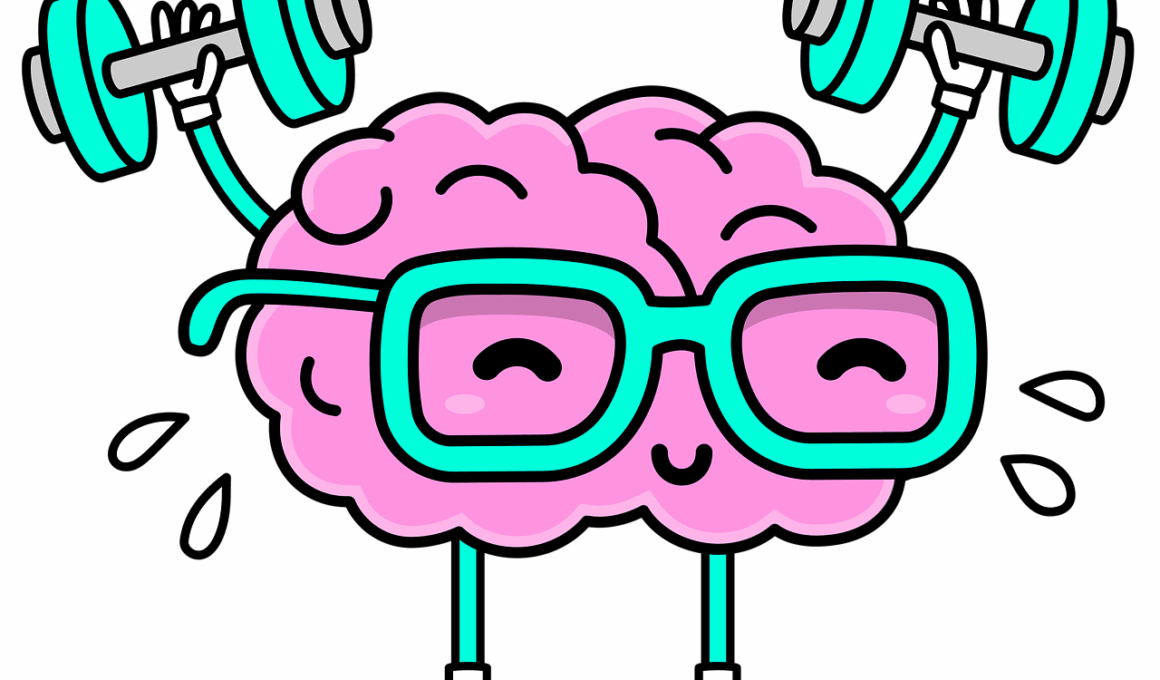Understanding the Neuroscience Behind Motivation for Fitness Success
Motivation plays a critical role in achieving fitness goals. Our brains are wired to respond to motivation through various neurochemical pathways. These pathways involve neurotransmitters such as dopamine, which is crucial in the reward system. When we engage in physical activity, our brain releases dopamine, providing feelings of pleasure and satisfaction. This reward reinforces the behavior, encouraging repetition. However, understanding how to sustainably tap into this motivation can be challenging. Factors such as stress, fatigue, and negative experiences can interfere with the release of dopamine, making it crucial to develop strategies to enhance motivation. Setting achievable goals is one way to stimulate this neurochemical response. When you set and achieve small fitness goals, it can lead to a positive feedback loop that encourages continued effort. Other factors influencing motivation include social support and environment. When surrounded by supportive individuals, we are more likely to engage in fitness activities. By exploring the neuroscience of motivation, we can discover effective ways to overcome barriers, leading to long-lasting fitness success and overall well-being.
How Neurotransmitters Influence Motivation
Neurotransmitters are pivotal in shaping our motivation levels. Besides dopamine, serotonin also plays a significant role in feelings of well-being and happiness. This neurotransmitter is known to influence mood and emotional states, which can directly affect motivation in fitness activities. Physical exercise has been shown to increase serotonin levels, promoting a sense of happiness and positiveness. Furthermore, endorphins are released during vigorous exercise, resulting in a natural high that can motivate individuals to engage in workouts consistently. Notably, understanding the balance of these neurotransmitters can provide insight into why some individuals may struggle with motivation while others thrive. It is essential to recognize that other lifestyle factors, like nutrition and sleep, can impact neurotransmitter levels. Eating a balanced diet rich in nutrients supports optimal brain function and overall neurotransmitter health, contributing to greater motivation. Additionally, ensuring enough quality sleep is critical, as sleep deprivation negatively affects neurotransmitter synthesis. By prioritizing these lifestyle factors and understanding their relationship with neurotransmitters, individuals can create an environment that fosters motivation and helps achieve fitness goals.
Goal setting is another essential element driving motivation in fitness regimes. The psychology of goal-setting is interconnected with the brain’s reward circuitry, making it a powerful tool in achieving fitness success. Goals provide a sense of direction and purpose, offering milestones to measure progress along the journey. Developing SMART (Specific, Measurable, Achievable, Relevant, Time-bound) goals can lead to higher motivation levels. When these goals are reached, the brain’s reward system is activated. Designing a structured plan not only enhances motivation but also helps in managing expectations. When individuals set realistic goals, they foster confidence and a sense of accomplishment as they achieve them. Furthermore, sharing goals with friends, trainers, or fitness communities can boost motivation. Social accountability encourages commitment and provides necessary support. Over time, this social interaction and feedback can enhance the experience, allowing individuals to remain focused on their fitness pursuits. Research has shown that when we celebrate small achievements, it enhances our intrinsic motivation, leading to sustained engagement in physical activities. Therefore, effective goal setting, integrated with an understanding of our brain’s response, can significantly enhance motivation levels.
Environmental Factors and Their Impact
The environment we are in plays a significant role in motivating us to pursue fitness goals. Numerous studies indicate that individuals are more likely to engage in physical activity when surrounded by supportive people or in an energizing physical space. Social influences, such as working out with friends or participating in group classes, can significantly enhance motivation levels. The presence of a workout partner can create a sense of accountability, pushing individuals to show up and perform, even on days when motivation wanes. Furthermore, environments that encourage physical activity, such as parks or gyms, can stimulate the desire to engage in exercise. Accessibility to fitness resources and programs also affects motivation. If individuals have easy access to fitness facilities, healthy food options, and knowledgeable support, they are more likely to persist in their pursuit of fitness goals. On the contrary, dull or isolating environments can dampen motivation levels. Therefore, creating positive, stimulating environments that foster physical activity can be a key element in motivating individuals toward their fitness journeys while simultaneously enhancing overall well-being.
In addition to environmental factors, mental conditioning significantly impacts motivation levels in fitness. The way we perceive and frame our experiences determines our ability to stay motivated. Adopting a growth mindset, viewing challenges as opportunities, can cultivate resilience in maintaining a fitness journey. In contrast, a fixed mindset can lead to discouragement and hinder motivation. Techniques such as visualization can enhance motivation by mentally rehearsing successful workouts or visualizing achieving fitness goals. This method not only increases motivation but also ingrains the desired outcomes in our subconscious. Additionally, positive self-talk can significantly influence motivation levels. Encouraging oneself with affirmations can counteract negative thoughts that may reduce motivation. Using mindfulness practices can help individuals become more aware of their thought patterns and feelings, allowing them to identify when motivation is lacking. By consciously working to reframe negative constructs, individuals can access a well of motivation and persistence. Hence, enhancing mental resilience and adopting motivational strategies can lead to improved physical outcomes while ensuring prolonged commitment to fitness activities.
Integrating Technology for Enhanced Motivation
With the advent of technology, numerous tools are available to help individuals enhance their motivation for fitness success. Fitness tracking apps allow users to set goals, track progress, and offer insights that can motivate them daily. The instantaneous feedback from tracking performance provides a sense of accomplishment, which reinforces continued effort and participation. Additionally, wearable devices such as fitness trackers and smartwatches provide users with real-time data, allowing them to monitor heart rates, calories burned, and activities completed. This information fosters an understanding of personal performance, which can motivate users to push beyond their limits. Social sharing features within many fitness apps can also help keep motivation levels high. By sharing progress on social media or within fitness communities, people can receive encouragement from others, creating a positive feedback loop. Moreover, fitness challenges and virtual competitions can maintain enthusiasm and competition among friends or community members. By harnessing technology effectively, individuals can create an engaging and motivating environment that fosters ongoing commitment to fitness pursuits and encourages continual progress toward their goals.
In conclusion, understanding the neuroscience of motivation is a powerful tool for achieving fitness success. By exploring various aspects of motivation, including neurotransmitters, mental conditioning, goal-setting, and the impact of the environment and technology, individuals can create a comprehensive strategy for enhancing their fitness journey. Engaging the brain’s reward systems is key; this can be achieved through consistent engagement in physical activities that encourage the production of feel-good hormones. Combining this with effective goal setting and utilizing social support can provide significant motivation boosts. Furthermore, fostering a positive mental state through techniques such as visualization and positive affirmations will help maintain long-term commitment to fitness activities. Lastly, employing technology to track progress and share experiences can further enhance motivation and accountability. By implementing these strategies, individuals can navigate the ups and downs of their fitness journey and remain committed to achieving their health and fitness goals. Understanding these concepts is essential for anyone seeking to maintain a lifestyle that combines fitness and motivation, paving the way for long-lasting improvements in their physical well-being.
The opportunities are endless for enhancing fitness motivation through a deep understanding of the neuroscience behind it. Tools, knowledge, and community support play significant roles in this journey. Engaging consistently with different strategies tailored to individual needs can maximize motivation effectively. The journey of fitness success may not always be linear, but remaining resilient and adaptable while integrating these neuroscience insights can foster lasting commitment. Utilizing the brain’s feedback loops through consistent engagement ensures that every step taken toward fitness excellence translates into increased motivation and improved outcomes. Embracing the interconnectedness of mental, social, and environmental factors will lead to a holistic approach that ensures sustained motivation for fitness. Emphasizing the effort and the joys of achieving small victories can create a fulfilling path toward fitness goals. Ultimately, the key takeaway is that understanding the neuroscience behind motivation and applying effective strategies empowers individuals to take charge of their fitness journey. With a thoughtful approach integrating various motivational facets, your fitness success is not just attainable—it can be incredibly fulfilling and transformative. Make fitness not just a goal but an enriching life experience.


